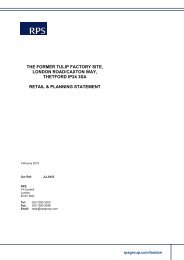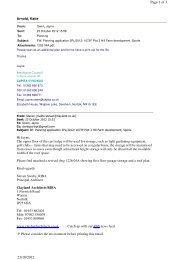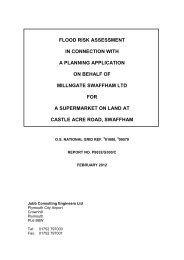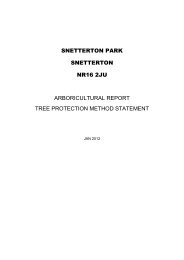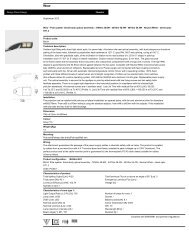Design and Access Statement Site: Lyng Farm, NR20 4JE
NR20%204JE%20Design%20and%20Access%20Statement.pdf
NR20%204JE%20Design%20and%20Access%20Statement.pdf
Create successful ePaper yourself
Turn your PDF publications into a flip-book with our unique Google optimized e-Paper software.
<strong>Design</strong> <strong>and</strong> <strong>Access</strong> <strong>Statement</strong><br />
<strong>Site</strong>: <strong>Lyng</strong> <strong>Farm</strong>, <strong>NR20</strong> <strong>4JE</strong><br />
Both day- <strong>and</strong> night-time lower fixed limits can be increased to 45 dB(A) to increase the<br />
permissible margin above background where the occupier of the property has some financial<br />
interest in the wind farm.<br />
In low noise environments the day-time level of the L A90,10min of the wind farm noise should be<br />
limited to an absolute level within the range of 35-40 dB(A). The actual value chosen within<br />
this range should depend upon: the number of dwellings in the neighbourhood of the wind<br />
farm, the effect of noise limits on the number of kWh generated, <strong>and</strong> the duration of the level<br />
of exposure.<br />
For single turbines or wind farms with very large separation distances between the turbines<br />
<strong>and</strong> the nearest properties, a simplified noise condition may be suitable. If the noise is limited<br />
to a L A90,10min of 35 dB(A) up to wind speeds of 10 m/s at 10 m height, then this condition alone<br />
would offer sufficient protection of amenity, <strong>and</strong> background noise surveys would be<br />
unnecessary.<br />
Assessment under BWEA St<strong>and</strong>ard<br />
As a comparison, the st<strong>and</strong>ard BWEA assessment method is given below for the Evance R9000<br />
Wind System.<br />
This approach is currently being revised to bring it into line with the now more accepted ETSU-<br />
R-97 approach used in the main body of this assessment.<br />
Acoustic Performance Estimate for typical 4.7m/s site<br />
Calculation<br />
Result<br />
Windspeed at 10 metre altitude mean<br />
speed from NOABL database<br />
4.7<br />
Using Rayleigh wind distribution to<br />
calculate the 90% windspeed at 10<br />
metres height.<br />
=1.72*<br />
= 8.08<br />
Using wind correction factor from 10m<br />
height using a power law (in accordance<br />
with IEC 61400-2) to estimate wind at<br />
installation rotor centre height, H<br />
(H=15m)<br />
= * = 8.76<br />
Turbine distance Noise Immission Point<br />





